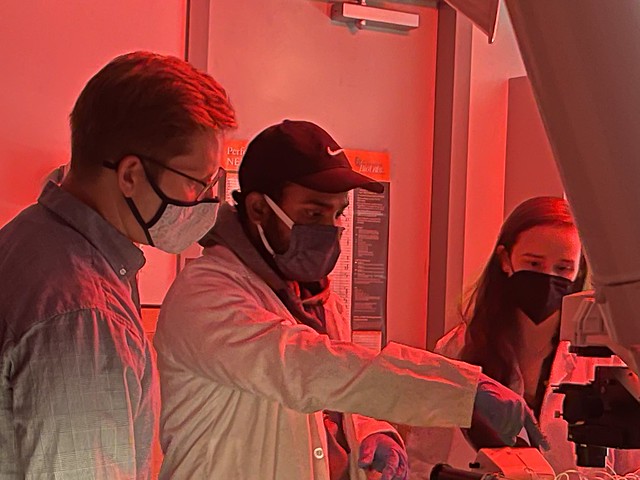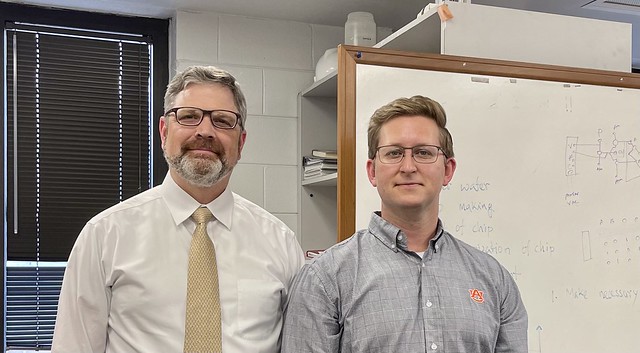Award-winning Auburn chemistry professor using $2.5 million in grants to propel diabetes research
Article body
Diabetes is a debilitating disease that affects millions of Americans, and one Auburn University researcher is hard at work—through the power of chemistry—to make a difference in the fight.
Chris Easley, the C. Harry Knowles Professor of Chemistry and Biochemistry in the College of Sciences and Mathematics, or COSAM, is leading a team of researchers on a quest to streamline and enhance biological measuring capabilities to better understand conditions like diabetes, heart disease and obesity. Buoyed by National Institutes of Health, or NIH, grants totaling $2.5 million, Easley is partnering with other professors and enlisting his research team to conduct experiments that may one day help medical professionals better understand, treat and prevent diseases, like diabetes, that are wreaking havoc across the globe.
“We are interested in helping understand the disease,” said Easley, the 2020 COSAM Dean’s Research Award recipient. “It’s a debilitating problem, especially in the southeast United States, but also all around the world. People everywhere have been affected by diabetes in some way.”
According to 2020 statistics from the Centers for Disease Control and Prevention, or CDC, more than 34 million Americans—more than 1 in 10—have diabetes. Another 88 million adults are prediabetic, pushing the total number of those in danger of being afflicted with the disease to more than 122 million, or nearly 1 in every 3 people.
Those percentages continue to climb, making research like that being done by Easley’s team—Easley Research Group—even more important to the American public. Through a twofold approach of examining cells at their most basic level and developing better physical tools of measurement, Easley hopes to make a profound impact.
“For diabetics, I think we still have a really good possibility for using our technology for measuring insulin or other hormones, like glucagon, in real time while you dose something like insulin or a diabetes drug,” said Easley, who won the Mid-Career Achievement Award from the Advancing Electrokinetic Science Electrophoresis Society in 2019. “Glucose meters are great, but it’d be really nice to be able to measure insulin, which is what people inject. It would be great to do a continuous insulin measurement so you know you injected the right amount and that you’re not going to create problems, like hypoglycemia.
“That could make a huge impact on the lives of diabetics who are trying to manage their blood glucose. It’s very helpful for people to have much more rapid feedback.”
Making a contribution
By providing data, information and results from various experiments, Easley’s team hopes to help doctors, scientists and leaders in other fields like pharmacy more effectively treat and fight diseases like diabetes.
“In terms of our adipose tissue biology research, we hope to understand more fundamentally how fat responds to stimuli like food or drugs, how fat secretes hormones and how that happens on a dynamic, short-time scale,” said Easley, a board member of Auburn’s Boshell Diabetes and Metabolic Diseases Research Program. “That’s just fundamental biology of how adipose tissue works. We hope to make an impact there so other people can use that information to possibly develop drugs or help in curbing some of the problems we have with obesity and diabetes.”
Using fat, or adipose tissue, the researchers can see how it reacts and functions in varying scenarios, and Easley’s team is partnering with Robert Judd from the Auburn University College of Veterinary Medicine and James Granneman at Wayne State University on their recently renewed NIH-funded project to make strides in the realm of research.
“We take small samples of this tissue and study their function at high temporal resolution,” said Easley, the graduate program officer for the Department of Chemistry and Biochemistry. “So, we build techniques and develop methods to help us understand the biology of these pathologies, like diabetes, obesity and metabolic syndrome.
“We hope to make tools that can help understand the fundamentals, which in theory could help us develop therapeutics for diabetes management or even prevention. We can also expand these tools into measuring biomarkers for many different diseases.”
In fact, the biosensing part of their work was recently funded by a second grant from NIH. Product development in the laboratory also is a big aspect of what Easley’s team concentrates on regularly, and it has worked closely with Auburn’s Office of Innovation Advancement and Commercialization, or IAC, for more than 10 years in that regard.
“Where we’re developing sensors, we also hope to make a direct impact on making clinical measurements in blood that can help people manage any disease,” said Easley, who serves as associate editor of the Royal Society of Chemistry’s journal Analytical Methods. “We are analytical chemistry people developing tools to make improvements in the understanding of biology, but also improvements in making clinical measurements faster.”
The power of technology
Easley’s team is using 3D printers to make many of the tools being utilized in the lab, a luxury that is allowing his research partners and team members to save considerable time and conduct a greater number of experiments than would be otherwise possible.
“Transformative is a good word,” Easley said of the technology. “The 3D printers allow us to customize our devices much better and do it with much lower expense for any of our instruments, and we use 3D printing in all aspects of our work now. We’re making sensors that can measure biomarkers in blood.
“We use them every day, multiple times a day, to help fabricate our microfluidic devices. These 3D printers have really accelerated our development of all of our technologies.”
Utilizing the devices they create, Easley’s team can perform a variety of experiments, including ones involving electrochemistry.
“We build instruments, do some circuit design and make our own custom instrumentation,” Easley said. “We developed a method where we can make this little electrode, where we use DNA strands and essentially coat the electrical sensor with these DNA strands that we make synthetically. We can use it for many different types of molecules to be detected with the same system.
“We hope to develop tools that labs can continue to use in the future to help understand the fundamentals of how tissues related to diabetes are functioning. So, we’re doing a lot of work now trying to make them more accessible to other laboratories.”
Powered by state-of-the-art technology, Easley can repeat and adjust experiments rapidly, streamlining the research process and maximizing results.
“Our technology—along with a lot of other technology in this field—is trying to push toward more rapid point-of-care measurements,” said Easley, an Auburn professor since 2008. “You can do rapid prototyping, and we can do testing quickly. Having measurements more quickly can be really advantageous.
“We think our technology can expand into measuring many other biomarkers of disease and drug molecules hopefully very quickly or in real time, where you can get a much quicker answer on a variety of different disease markers.”
Steadfast support propelling research, elevating department
Easley’s efforts have been supported by the NIH through its National Institute of Diabetes and Digestive and Kidney Diseases, or NIDDK. His team recently renewed a grant to the tune of $1.34 million through 2024, and the NIDDK award has contributed $3.76 million toward Easley’s research since 2012.
In addition, for the newly funded project on electrochemical biosensors, the NIH’s National Institute of General Medical Sciences, or NIGMS, allocated $1.19 million to Easley and Rashad Karimov from the Department of Chemistry and Biochemistry, giving Easley and his colleagues ample backing to continue their research.
“We’re very grateful to have the federal funding from the NIH, and it has been extremely supportive of the type of work we’re doing,” Easley said. “Some of the experiments we do are expensive and can’t be done without the funding, and we are always grateful for the support from Auburn University, from the chemistry and biochemistry department and from COSAM. It’s a huge benefit for us to continue our work.”
The seven-figure grants not only help Easley’s work make progress, but also serve as a major boost for the department.
“There really is no area of our department that’s not positively affected by grants like these,” said Doug Goodwin, chair of the Department of Chemistry and Biochemistry. “Everything is improved, and we have the ability to do more things in all areas of our mission. When funding like this comes into the department, it’s how you support graduate students in their research, and that, of course, leads to Auburn graduates going out into the world with doctorates to do their own research.”
Goodwin noted that Easley’s exploits are the latest in a long line of successes for the department.
“The funding in the Department of Chemistry and Biochemistry has really been on a great trajectory over the last several years,” Goodwin said. “We’ve had seven National Science Foundation CAREER awards among our junior faculty in the last 10 years, and that’s a level of success you’re not going to find at many other institutions.
“What Chris is doing with his research and the visibility that brings to the department, that enhances the kind of people who are going to be applying to become faculty in our department, and I think that’s very exciting. It really enables us to go to the next level as a department.”
And another fundamental way the department, COSAM and the university continues to ascend is by contributing to the benefit of humanity.
“When you look at what can be gained from the research in terms of how it can help the broader good, the global community and all of these areas, it’s amazing,” Goodwin said. “We’re doing research that’s advancing what we’re going to be able to do to address global problems with disease, global problems in the energy sector and global problems in terms of the environment, and our department is participating in all of those areas. As an administrator and a department chair, it’s really quite fulfilling to be part of that and to have a role in our faculty continuing to make those kinds of contributions.”
Related Media
Media interested in this story can contact Communications Director Preston Sparks at (334) 844-9999 or preston.sparks@auburn.edu.
Auburn University is a nationally ranked land grant institution recognized for its commitment to world-class scholarship, interdisciplinary research with an elite, top-tier Carnegie R1 classification, life-changing outreach with Carnegie’s Community Engagement designation and an undergraduate education experience second to none. Auburn is home to more than 30,000 students, and its faculty and research partners collaborate to develop and deliver meaningful scholarship, science and technology-based advancements that meet pressing regional, national and global needs. Auburn’s commitment to active student engagement, professional success and public/private partnership drives a growing reputation for outreach and extension that delivers broad economic, health and societal impact.







